Natural textures, earth-toned finishes, and cozy lighting are changing the way homeowners think about bathroom design. The rise of warm bathroom ideas speaks to a growing desire for comfort-driven interiors that feel both stylish and soothing. As cold, sterile aesthetics fade, people are turning toward wood vanities, creamy tiles, and ambient lighting to create spaces that feel lived-in and welcoming. This guide reveals the most compelling design directions for adding warmth without sacrificing function or style. Whether you’re remodeling or starting from scratch, these carefully selected ideas offer accessible ways to bring a relaxed, inviting atmosphere to your daily routine.
Terracotta Tile Drenching
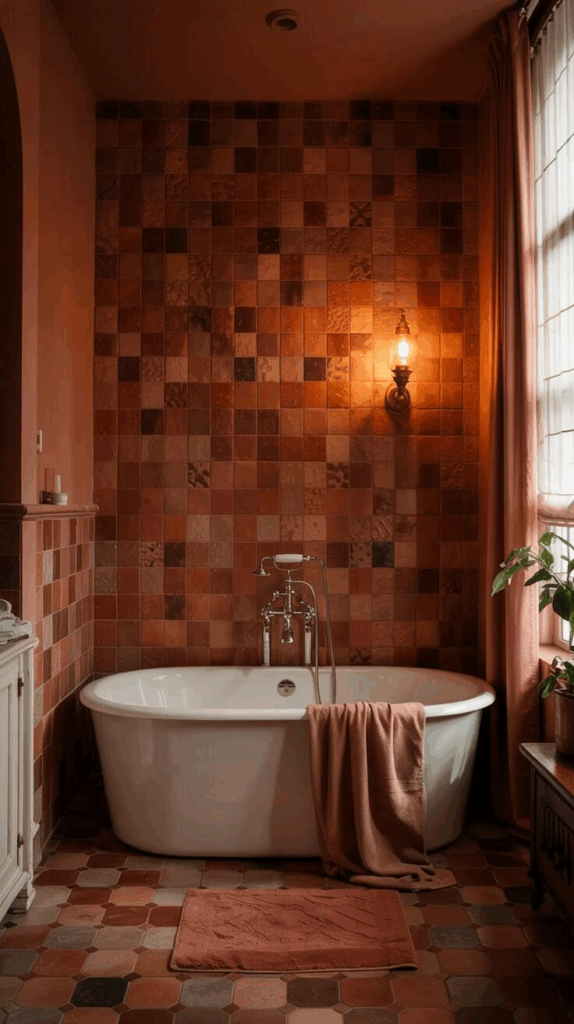
Drenching the walls and floors in terracotta tiles creates a grounded, Mediterranean-inspired bathroom that radiates warmth. This design choice isn’t just about color—it’s about character. Terracotta’s earthy red-orange undertone introduces a sun-baked vibe that instantly softens sterile spaces. These tiles age beautifully, developing a patina that adds authenticity over time. Use them floor-to-ceiling for immersive impact or break it up with creamy plaster walls for contrast. The natural variation in tone brings depth without feeling overdone, making it ideal for those craving a warm aesthetic that doesn’t rely on artificial elements. When paired with matte finishes and rustic grout lines, terracotta tiles strike a comforting balance between texture and tradition. For continuity, consider matching terracotta shades in accessories like soap dishes or towel hooks. Sealing is essential to maintain durability and avoid moisture absorption—especially in high-humidity zones. Whether arranged in a herringbone, stacked, or staggered pattern, terracotta delivers a bold foundation that feels timeless yet modern. It’s an intentional design move that invites warmth without overwhelming the senses. Ideal for climates both cold and warm, this material is a tactile, soul-soothing alternative to sterile porcelain or all-white palettes, offering a truly grounded bathroom experience.
Vintage Wood Vanities

Selecting reclaimed or vintage wood vanities can instantly infuse warmth and personality into your bathroom layout. The natural grain, worn edges, and soft patina of aged wood offer visual interest while grounding the space in organic charm. Whether it’s a rustic dresser repurposed with a vessel sink or a farmhouse-style cabinet with paneled doors, vintage wood brings character and function in equal measure. These vanities often come with built-in imperfections, which act as a design advantage in warm-themed interiors—each scratch or knot tells a story, avoiding the overly polished or sterile look. Pairing the wood tones with neutral or creamy walls helps highlight the material without overpowering the room. Hardware in antique brass or aged iron further supports the warm aesthetic. Vintage vanities also allow room for customization: update drawers for better storage or install a custom countertop in marble or quartz for modern durability. This mix of old and new adds richness that resonates with both traditional and contemporary design lovers. The key is choosing wood tones with golden, honeyed, or walnut hues that lend a cozy ambiance. It’s a grounding design feature that effortlessly blends function, beauty, and history into one cohesive focal point.
Brass Accents

Integrating brass accents into bathroom fixtures and décor introduces a golden warmth that complements both minimalist and layered interiors. Unlike chrome or nickel, brass has a slightly muted glow that leans toward vintage and cozy rather than sleek and modern. The trick is in balance—pairing warm brass taps, mirror frames, and lighting fixtures with matte finishes and soft neutrals helps prevent the space from feeling over-glamorous. Look for unlacquered or brushed brass finishes for a more subdued, lived-in feel that patinates naturally over time. This evolving surface quality makes each piece more unique and visually rich with age. Brass harmonizes effortlessly with earthy palettes—think clay tiles, olive tones, or creamy beiges—making it a versatile metal that works well across rustic, transitional, and contemporary styles. Light fixtures with brass arms, drawer pulls, towel rings, and even trim edging on vanities can subtly unify the space. For those hesitant to go full brass, start with small touches like a framed mirror or wall sconce before expanding into hardware and faucets. The goal is to create a cohesive glow throughout the bathroom that radiates understated luxury. Brass adds a timeless warmth that feels intentional and elevated, yet inherently inviting.
Textured Wall Panels
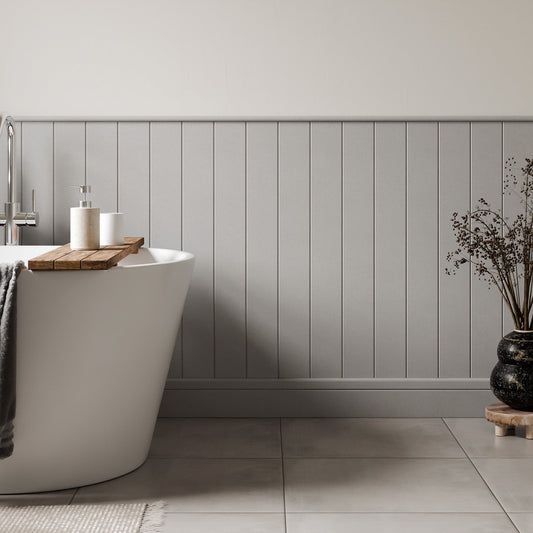
Textural wall treatments offer an underutilized yet transformative way to infuse warmth into bathroom design. Vertical wood slats, ribbed tiles, or paneling with natural grain elevate the visual experience while adding tactile comfort. Instead of relying solely on color, textured walls create dimension through light and shadow, giving depth to otherwise flat surfaces. When bathed in soft lighting, these textures come alive—perfect for fostering a cozy, spa-like ambiance. Warm-toned panels in oak, walnut, or even painted beadboard help soften sterile walls and tie in beautifully with organic flooring and fixtures. Some homeowners choose fluted wall panels behind mirrors or sinks to make a design statement without adding visual clutter. Moisture-resistant materials such as PVC-based panels or treated natural wood make this style functional and long-lasting in humid environments. For contrast, pair smooth ceramic surfaces with textured panels to strike a balanced and layered aesthetic. The result is a calming environment that feels curated and intimate. Whether used on a feature wall or across the entire room, texture plays a vital role in warming up contemporary or rustic bathrooms alike. This subtle detail encourages a slower, more sensory experience—precisely what a bathroom retreat deserves.
Earth-Toned Color Palette

Infusing a bathroom with earth-toned hues sets a tranquil and grounding atmosphere. From clay and sand to olive and taupe, these colors mimic nature’s own spectrum, allowing the space to feel connected to the outdoors. Unlike stark whites or greys, earth tones offer a gentle warmth that doesn’t compete with other elements in the room. Walls painted in muted terracotta or mushroom beige provide a neutral backdrop while still radiating personality. These tones work especially well with organic textures like wood, stone, and woven textiles, helping all elements coexist harmoniously. Even fixtures like bathtubs or sinks in warm matte hues—such as almond or biscuit—can tie into the palette for an all-around inviting finish. Integrating color through paint, tile, towels, or cabinetry gives flexibility to layer warmth without overcommitting. Keep the lighting soft and slightly yellow to complement these tones, as harsh white bulbs can dull their richness. For added depth, include tonal variations—mixing darker rusts with softer oat shades—for a space that feels layered without being overwhelming. Earth tones evoke comfort, stability, and natural beauty—making them an ideal base for any warm bathroom concept that aims to soothe and restore.
Natural Stone Elements
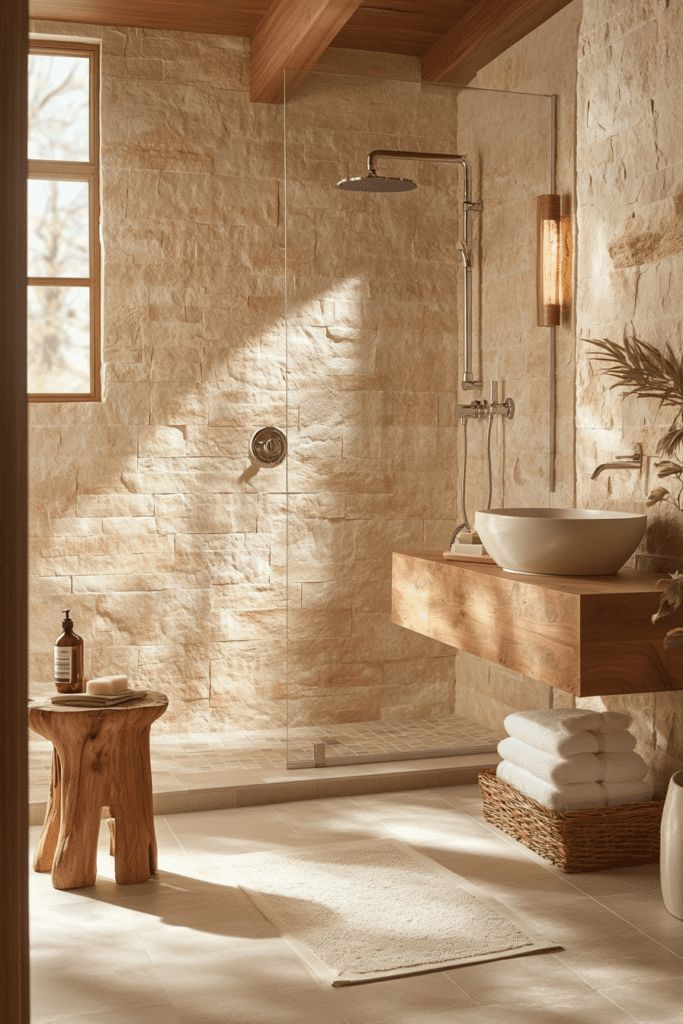
Integrating natural stone into a bathroom introduces warmth not just through tone, but through touch and visual texture. Limestone, travertine, and honed marble lend a sense of timeless elegance while keeping the space rooted in organic comfort. Their subtle veining, irregular edges, and matte finishes feel tactile and earthy—ideal for those steering away from the sterile perfection of high-gloss tiles. Whether used in flooring, countertops, or shower surrounds, these stones bring durability and depth to the overall design. Prioritize soft, warm undertones—creamy beige, soft brown, and muted ivory—to align with the warmth-focused aesthetic. Stone basins or shelves can double as artful accents, making the material not just functional, but a focal point. To maintain practicality, ensure the surfaces are sealed properly, especially in areas prone to high moisture. Stone pairs beautifully with wood, metal, and woven accessories, creating a naturally cohesive palette. Instead of loud contrasts, the beauty here lies in softness and harmony. Natural stone makes a quiet statement—rooted in history yet effortlessly contemporary—and provides a textural anchor that supports the rest of the warm design choices. It’s a design investment that pays off both visually and functionally for years to come.
Ambient Lighting

Lighting is more than a utility—it shapes how a bathroom feels, especially when warmth is the goal. Soft, layered lighting instantly shifts the mood from stark to soothing. Use dimmable fixtures and opt for bulbs with warm color temperatures (2700K–3000K) to cast a golden hue that mimics natural sunlight. Rather than relying solely on overhead lighting, incorporate multiple sources: sconces at eye level, under-cabinet LED strips, and even backlit mirrors can all contribute to a cocoon-like atmosphere. Fixtures made of warm metals or frosted glass can subtly reinforce the inviting tone without overwhelming the space. Recessed ceiling lights can be softened with amber-toned bulbs, while pendants can bring style and glow over vanities or tubs. If space allows, consider wall-mounted candles or diffused lanterns to evoke a spa-like environment. Avoid harsh fluorescent or cool-toned LEDs, which can make even the most carefully designed bathroom feel sterile. Thoughtful lighting design helps highlight natural materials like stone or wood while creating calming shadows and highlights. When done right, ambient lighting serves as the final layer that ties together warmth across color, texture, and material—making the bathroom not just functional, but emotionally resonant.
Warm Wood Flooring
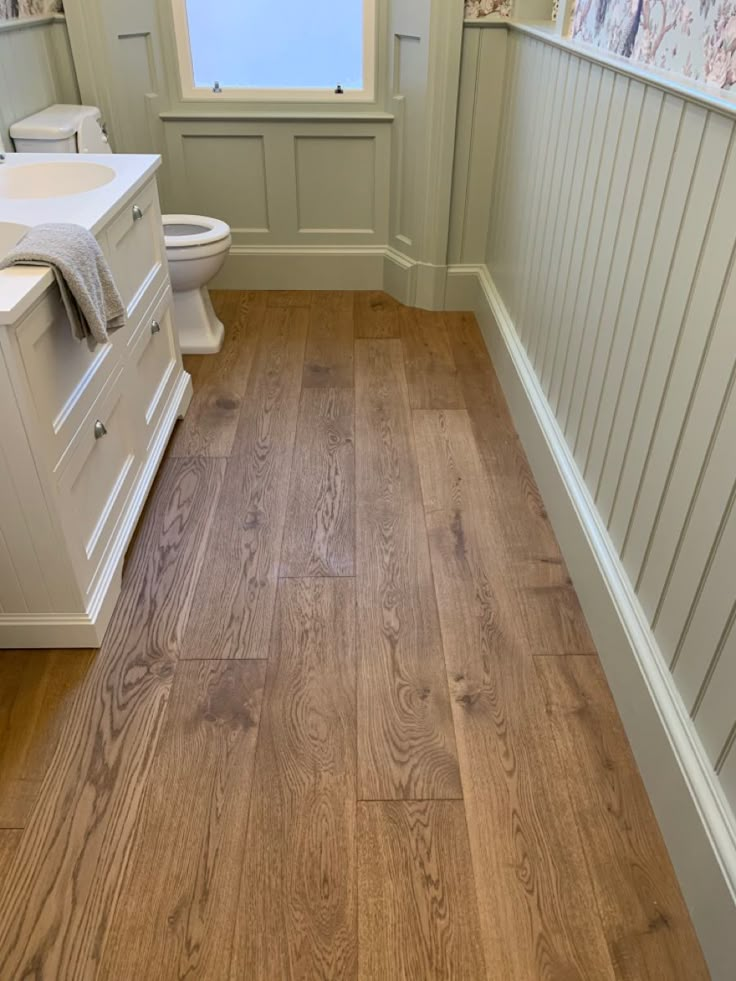
Wood flooring in a bathroom creates a luxurious, unexpected foundation that radiates comfort. Engineered wood or water-resistant laminate versions provide the beauty of hardwood with the durability needed for wet zones. Honey oak, teak, or walnut tones are especially effective for contributing natural warmth. Their grain patterns introduce organic movement underfoot, making even minimalist spaces feel inviting. For those concerned about moisture, properly sealed planks or luxury vinyl planks that mimic real wood offer a smart compromise. Pairing wood flooring with stone sinks or textured walls heightens the sensory contrast, enhancing the room’s overall richness. Heating elements beneath the floor can add extra comfort during colder months—ideal for spa-inspired retreats. To maintain visual continuity, extend wood tones into cabinetry or mirror frames. Avoid cooler ash or gray-washed tones, which can detract from the desired warm ambiance. The slight imperfections in wood grain and finish tell a story, grounding the space in authenticity. With its ability to soften sharp lines and modern forms, warm wood flooring remains a highly functional and aesthetically pleasing element in a bathroom that prioritizes comfort, elegance, and a connection to nature.
Soft Textiles
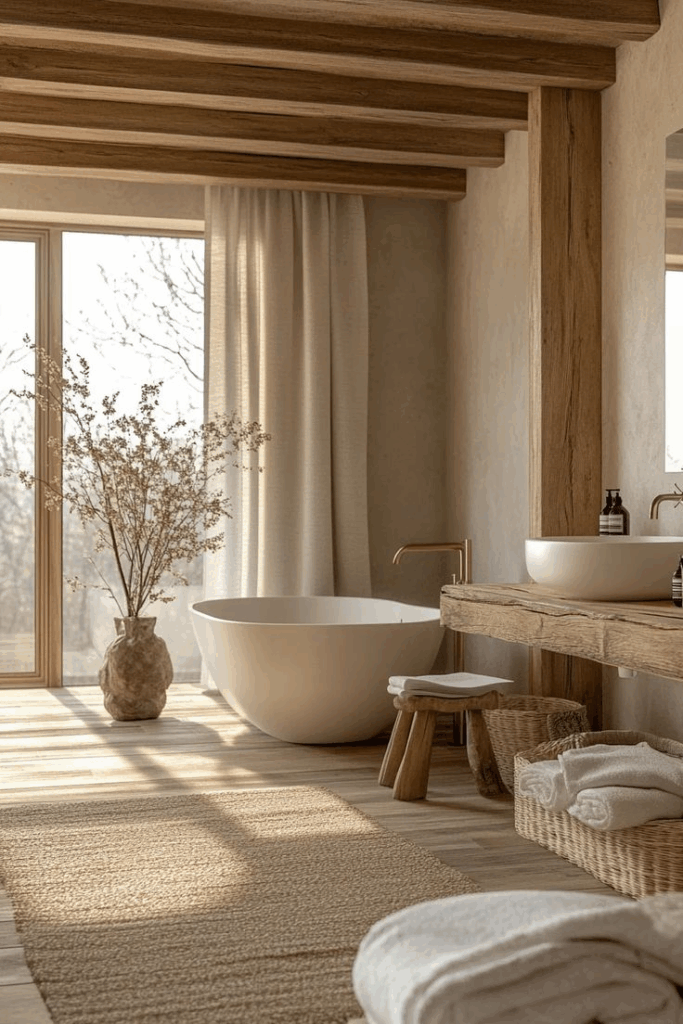
Textiles play an essential role in warming up a bathroom’s visual and tactile environment. Swapping out stiff, clinical fabrics for plush towels, handwoven rugs, and natural fiber curtains transforms the room into a welcoming escape. Opt for Turkish or waffle-knit cotton towels in muted earth tones like sand, sienna, or ochre to introduce warmth without overwhelming color. Linen shower curtains in flax or warm ivory can provide an airy softness that balances denser textures like wood or stone. A small vintage-style rug or kilim mat with rust, olive, or terracotta accents adds instant comfort underfoot and visual coziness. Consider hanging lightweight fabric shades over frosted windows for filtered sunlight that complements the overall ambiance. Look for natural materials—cotton, bamboo, linen—that breathe well in humid environments and offer long-term durability. These textiles not only improve comfort but also absorb sound, reducing echo and adding acoustic warmth. Avoid overly bright or synthetic options, which can feel jarring in a space focused on restfulness. Every piece of fabric becomes an opportunity to soften surfaces, balance texture, and complete a room that invites relaxation. When thoughtfully chosen, textiles bring a lived-in elegance that finishes a warm bathroom with tactile serenity.
Live Greenery
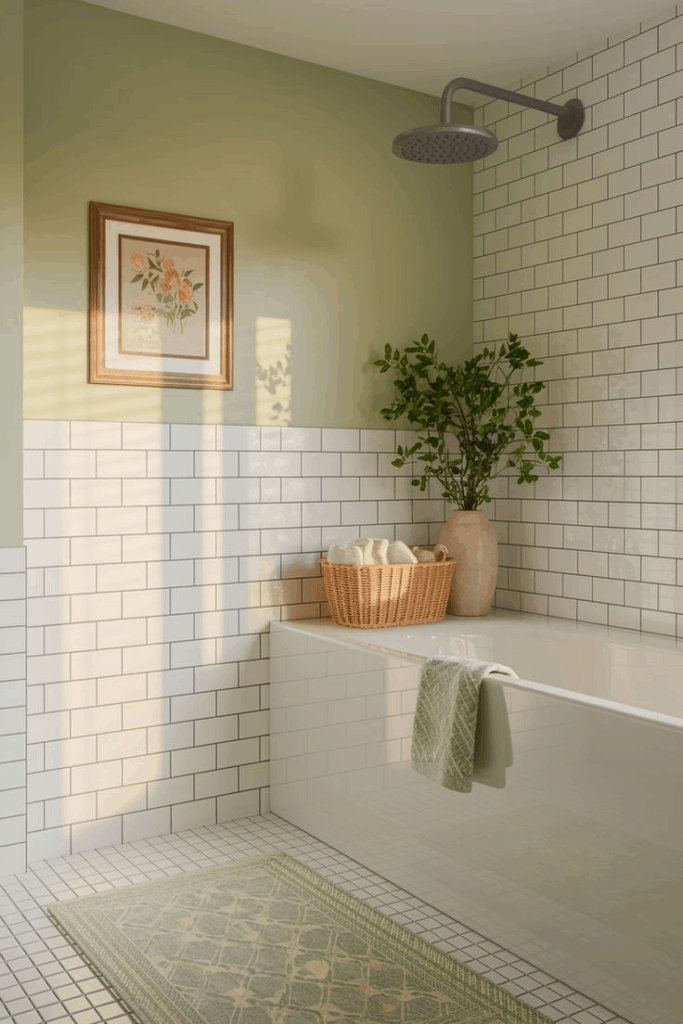
Introducing greenery into a bathroom doesn’t just freshen the air—it visually and emotionally warms the space. Potted plants with lush foliage or trailing vines can soften architectural lines and bring natural rhythm to sterile zones. Choose species that thrive in humidity and low-light conditions, such as pothos, ferns, peace lilies, or spider plants. Strategically place them near windowsills, on open shelves, or in hanging baskets to maximize visibility without obstructing functionality. Live greenery complements earth-toned palettes and textured surfaces by adding life and color contrast that still feels organic. Even small arrangements—like a single plant on the vanity or a leafy stem in a ceramic vase—can transform the mood. For added texture, use terracotta, stone, or woven planters that echo the bathroom’s warm material story. Group plants in odd numbers to create natural-looking clusters without feeling cluttered. Greenery encourages a connection to nature, making the bathroom feel less mechanical and more personal. In addition to aesthetic benefits, many houseplants help purify air and regulate humidity, enhancing overall wellness. In a space designed for restoration, greenery serves as both a visual balm and a subtle statement of tranquility, tying every warm element together with vibrant ease.
Artisan Accessories
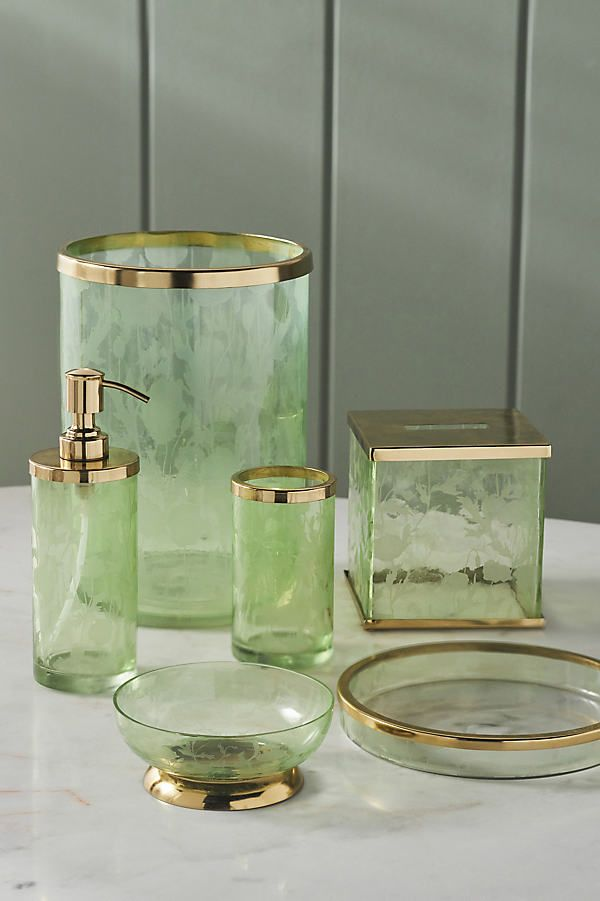
Handmade décor and accessories personalize a bathroom while enhancing its warmth. Swapping out mass-produced elements for artisanal pieces—think hand-thrown ceramic soap dishes, woven baskets, carved wooden trays—adds character that elevates everyday routines. These items tell a visual story, revealing craftsmanship and detail that align with the overall comfort-driven theme. Seek out irregular finishes, natural glazes, and textures that speak to human touch rather than machine perfection. For storage, baskets woven from jute or seagrass keep things organized without compromising style. Handmade wall hooks, towel bars, or even framed textile art can serve as functional accents while anchoring the room’s material richness. Use clay or matte-glass containers to hold essentials like cotton swabs or bath salts, adding a quiet elegance to your countertop. These accessories also introduce layers of warm neutrals and natural fibers, balancing hard surfaces like stone or tile. Supporting small-batch makers or local artisans lends a sense of authenticity that off-the-shelf items often lack. Artisan details are the connective tissue of a warm bathroom—providing tactile nuance, visual variation, and a sense of thoughtful curation. When every piece feels intentional, the space invites comfort and personal connection, not just style.
Warm Metallic Finishes
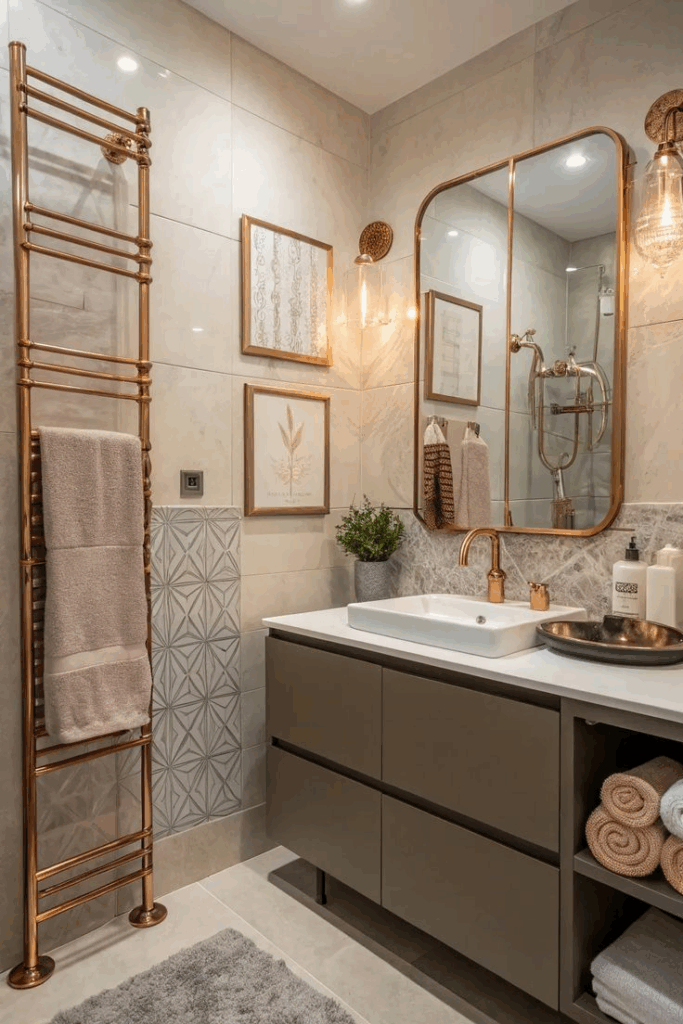
Choosing warm metals like antique brass, copper, or champagne bronze brings understated elegance and comfort into bathroom design. Unlike colder chrome or polished nickel, these finishes glow with a golden undertone that enhances soft lighting and earthy materials. When applied to faucets, mirror frames, lighting, or drawer pulls, warm metallics become functional jewelry—adding subtle shine without feeling flashy. Use aged finishes to introduce depth and patina that complements vintage elements or textured walls. Brushed or satin options are especially effective at softening reflections while minimizing fingerprints—ideal for everyday use. These metals coordinate beautifully with terracotta, warm stone, or wood, helping unify the entire aesthetic without forcing contrast. Consider mixing metals in the same tone family to avoid a matchy-matchy look while maintaining cohesion. Even small applications—such as a warm-toned towel bar or soap dispenser—can make a noticeable impact when thoughtfully placed. Unlike cooler finishes that can feel detached, warm metals invite touch and complement the sense of relaxation a bathroom should evoke. The overall effect is a refined warmth that’s both functional and visually comforting, making it easier to curate a space that feels rich, relaxing, and well-balanced.
Layered Textures
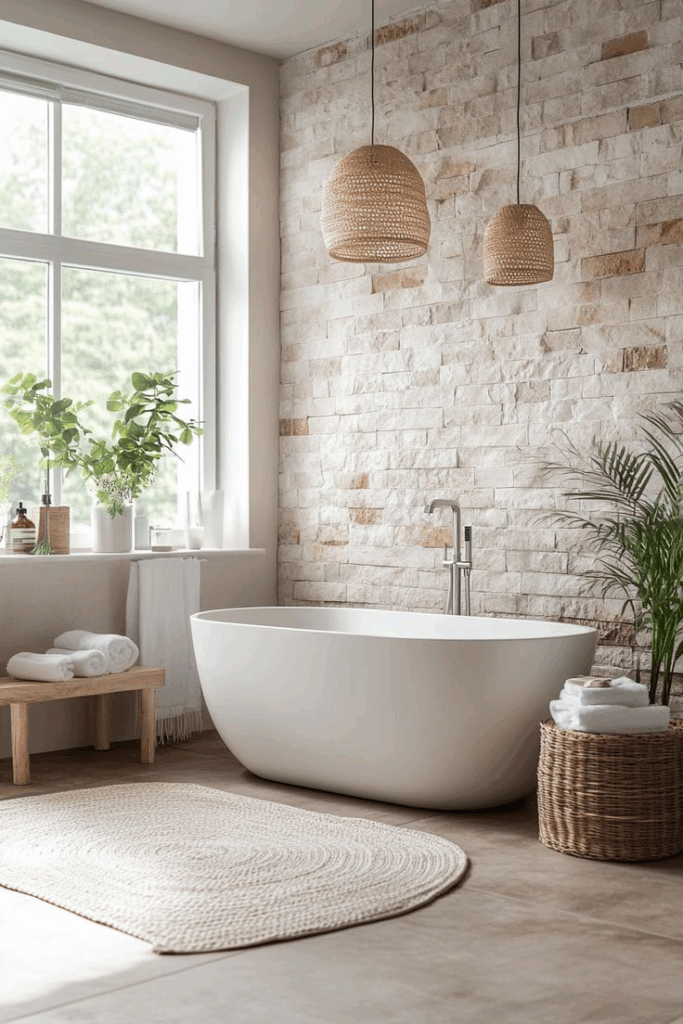
Blending multiple materials within a bathroom fosters a layered warmth that’s both visual and tactile. This technique is less about contrast and more about cohesion—bringing together wood grains, stone finishes, woven fibers, and soft fabrics in a way that feels natural. For instance, a rustic oak vanity paired with matte stone countertops and a jute rug introduces three distinct textures that harmonize rather than compete. Wall treatments like limewash or tadelakt plaster further deepen the atmosphere by adding subtle movement. Tactile variation also prevents the space from feeling flat or sterile, encouraging a slower, more sensory experience. Choose accessories that continue the texture story—think handwoven baskets, sculpted ceramics, and even hammered metal trays. Textures should be felt as much as seen, whether it’s a slubby linen curtain or a ribbed tile backsplash. Stick to a consistent color palette of warm neutrals and earth tones to avoid visual overload. Layering doesn’t require excess—it just means every element contributes something unique. Done well, this approach wraps the space in comfort and interest, resulting in a bathroom that feels curated and personal. Texture is often the missing link between design and emotion—and in a warm bathroom, it becomes essential.
Warm-Toned Mirrors
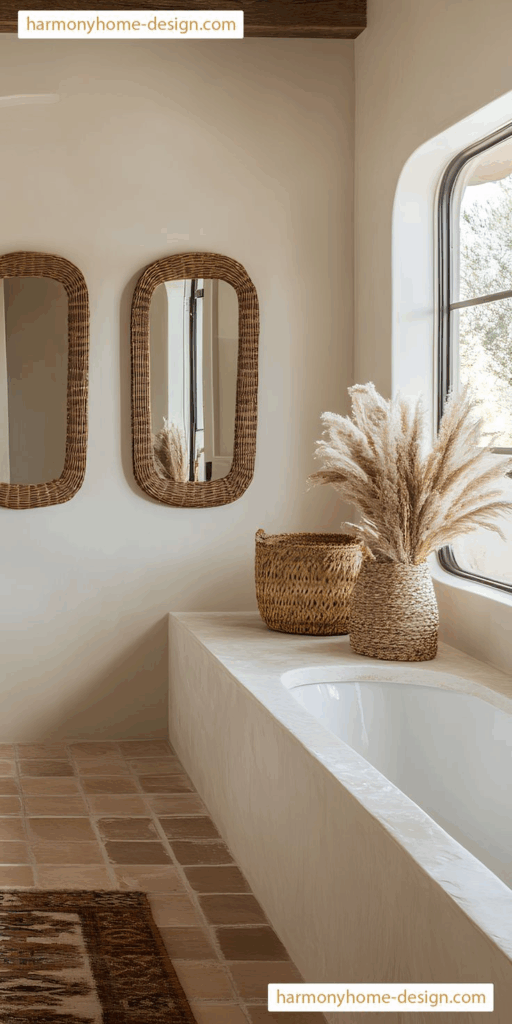
Mirrors do more than reflect light—they shape a bathroom’s visual narrative. Choosing mirrors with warm-toned frames adds both function and depth to the design. Think wood-framed options in walnut or honey oak, brushed brass borders, or even ceramic-edged pieces in natural hues. These materials enhance the sense of comfort and tie in seamlessly with earth-toned palettes. Instead of going for sterile chrome or frameless glass, opt for pieces that feel intentional and crafted. Round or oval shapes tend to soften rigid lines and echo the organic rhythm of warm aesthetics. For added impact, consider backlit mirrors with warm LEDs to boost ambient lighting while accentuating material warmth. Placement matters—above vanities, behind freestanding tubs, or even leaned against walls to increase visual flow. These mirrors don’t just bounce light—they amplify warmth by complementing surrounding textures like tile, wood, or plaster. For smaller bathrooms, a well-positioned mirror framed in warm material can expand the space while reinforcing the cozy atmosphere. Decorative but not flashy, mirrors with warm frames serve as anchors that visually balance harder elements and encourage a feeling of tranquility and softness throughout the room.
Scented Elements

Aromas complete the sensory experience of a warm bathroom, tying together visual comfort with emotional relaxation. Scented elements like essential oil diffusers, natural soy candles, and dried herbs add invisible warmth that invites slow, intentional living. Choose fragrances aligned with earthy tones—think sandalwood, cedar, vanilla, amber, or spiced citrus. These scents evoke comfort without overwhelming the senses, enhancing the mood in subtle ways. Display candles in terracotta or glass containers that align with the room’s palette, or use a minimalist reed diffuser for consistent background aroma. Hanging bundles of eucalyptus in the shower can offer a gentle scent release with each use, while also adding a botanical touch. Avoid synthetic air fresheners that clash with the organic, grounded atmosphere. Scent layering—through bath salts, hand soaps, or even linen sprays—builds a cohesive olfactory profile. Scents should not be an afterthought; they’re an essential part of emotional design. Just as texture and lighting create visual ambiance, aroma fosters memory and calm. When carefully chosen, scented elements turn a functional space into a sensory retreat, helping users relax, reset, and reconnect. The experience becomes not just about sight, but about how the space makes you feel.
